You are using an out of date browser. It may not display this or other websites correctly.
You should upgrade or use an alternative browser.
You should upgrade or use an alternative browser.
***Official Squad Thread***
- Thread starter Xcept1
- Start date
More options
View all postsCurrently you need a hefty system. The unlimited draw distance and number of players currently takes a hit on fps. New animation system and moving to the latest Unreal Engine version will improve things somewhat but don't expect anything like 165fps on any system!
Would a 6gb 1060 cut the mustard or do I need to go higher? Just seems weird that it is low no matter how low I set the settings. And it looks (obviously) terrible then.
Squad is very CPU dependant. I run a 4790k at 4.7 + 970 with a slight OC on and get around 50/60 fps on ultra at 1080p.
Really enjoying the game though. First game in so long that I have. Excellent team work good gameplay. Frankly it's helped enormously by having such a solid base of British lads.
Recommendations:
Location filter for games when it's released. Counter strike lost it having to play Russians. So good at the moment.
The Russians tend to stick to their own Russian servers. They have a healthy community in Squad and tend not to venture too far!
Rockets are pretty under powered. Too many instances of the armoured vehicles ******* everyone's **** up taking hits and then scooting off because people are out of rockets.
HAT kit is a one hit kill against all armour currently in game.
Also if I'm a anti tank with a RPG launcher and then an enemy pops up at close range I should be able to drop the thing and get my gun out not neatly fold away the sites before getting my back up ak out.
Kind of working as intended. If you have your main weapon down then make sure your squad mates are covering you. Animation changes will come so you can interrupt weapon switching.
Also sharing ammo. We were pinned down and a couple lads were low on ammo. Would be nice to be able to share mags.
Coming.
Maybe being able to put bipods on window sills.
Also coming.
Clarify the gun firing seems to hit window sills etc quite often. Guessing sights higher than barrel but should should lift gun to compensate. Makes it difficult to keep cover without compromising.
Bullets come from the barrel not the middle of the screen in Squad so make sure the muzzle is clear. Having said that, windows are currently annoying as hell and a "soft cover" system is in the works.
On the whole though a great game. Where graphics performance is a work in progress the audio more than makes up for it. Exceptional.
Thanks! Anders the sound guy is amazing. Looking forward to seeing what he can do with the helicoptersNot long before the next update then it's all about v10!
Hi Squaddies!
It's time for another Squad update and special event announcement!
In conjunction with several of our community partners we are excited to announce a special game mode testing event this coming Sunday, April 30th at 2 PM PST.
Our community partners came up with some ideas that we've crafted into two very simple gameplay layers, so on Sunday we're all about stretching the boundaries of everyday Squad play to test an experimental map and game mode!
Desmo's playground - VC_v1 (Vehicle Combat)

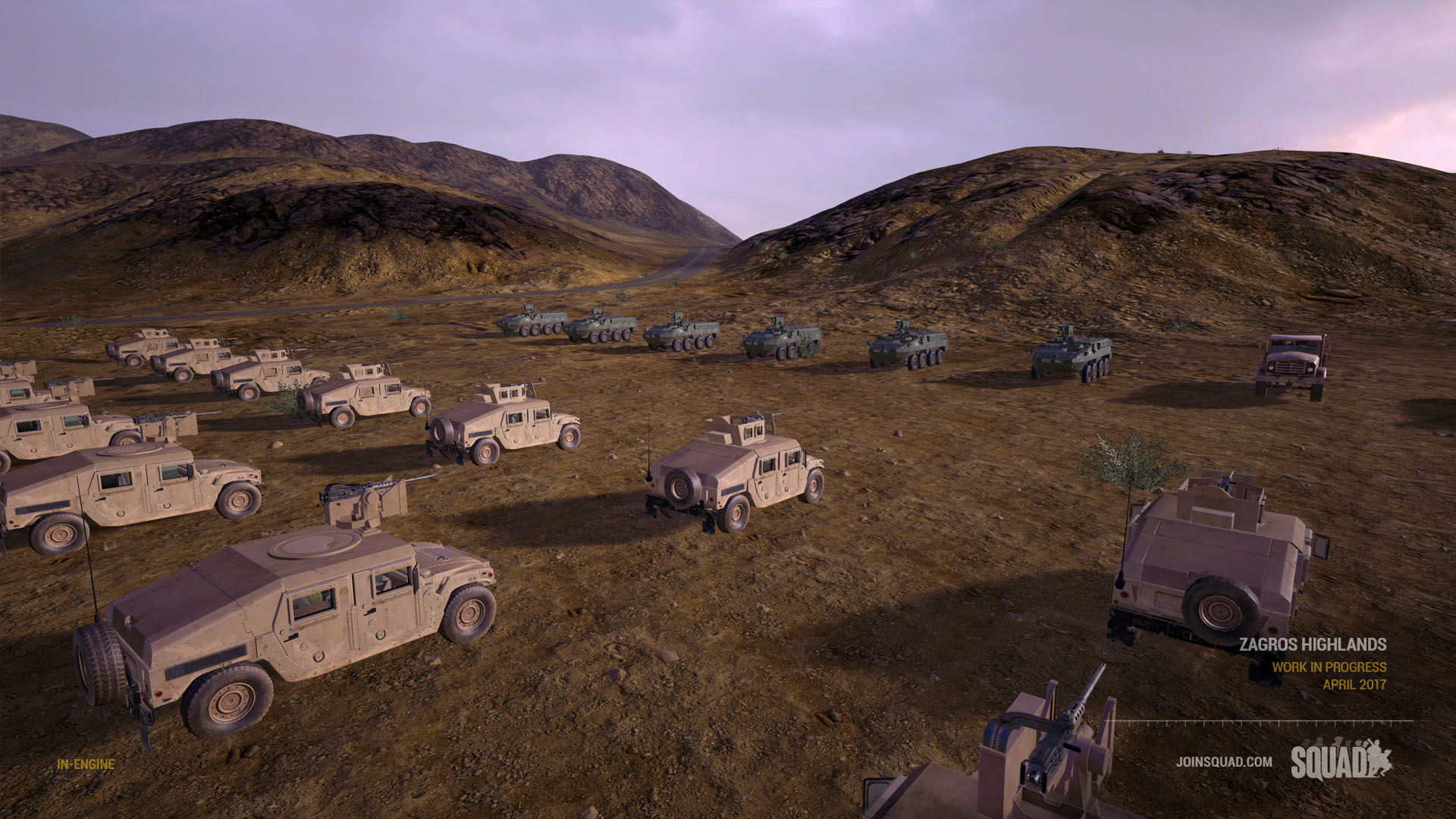
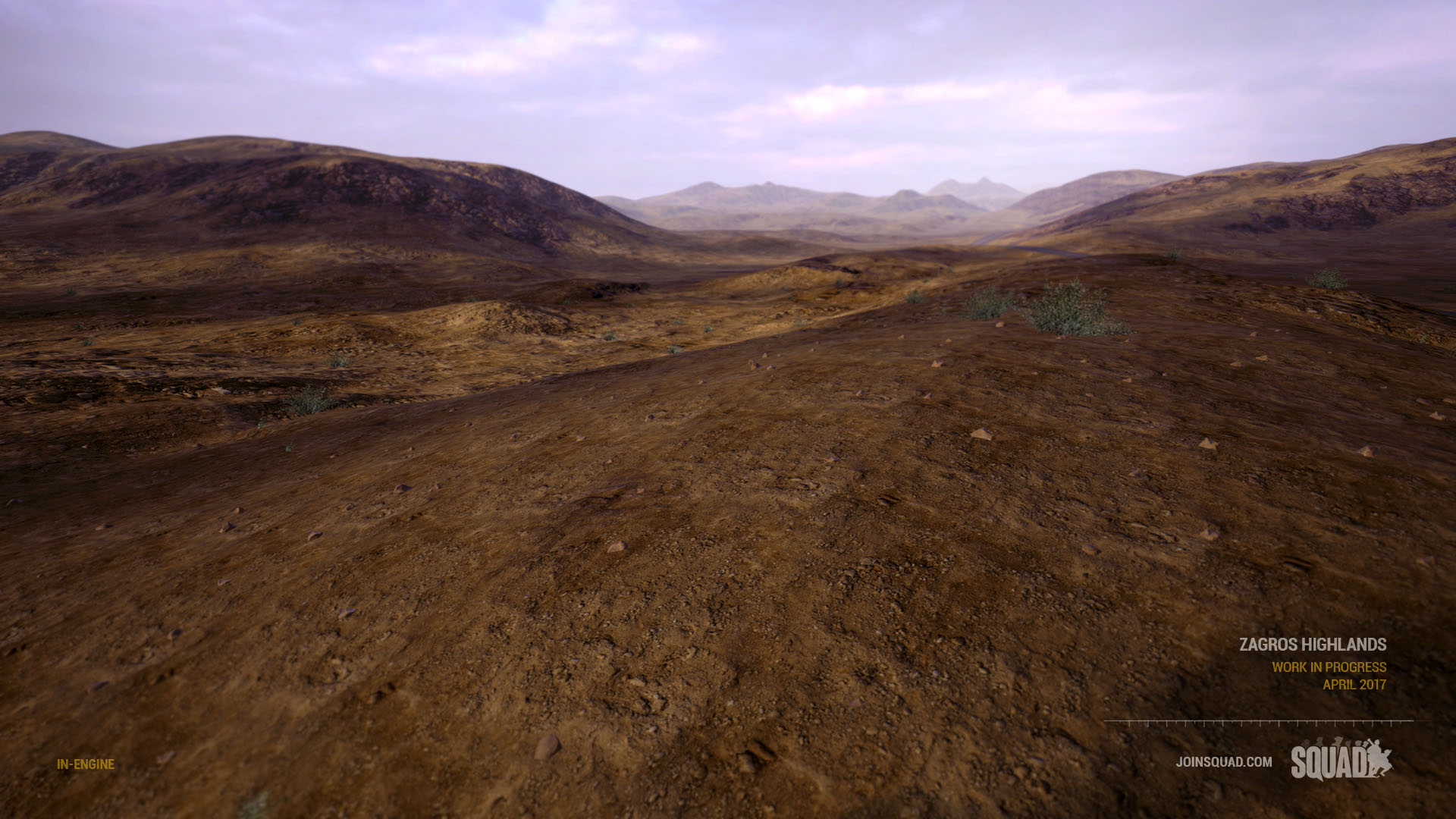
Designed by our very own DesmoLocke, this layer consists of enough vehicles to mount an entire team in extended vehicular warfare. With 50 vehicles, 1000 tickets, and 3 very large control zones, we are certain to get into some wild adventures!
Zagros Highlands - Conquest Hardened

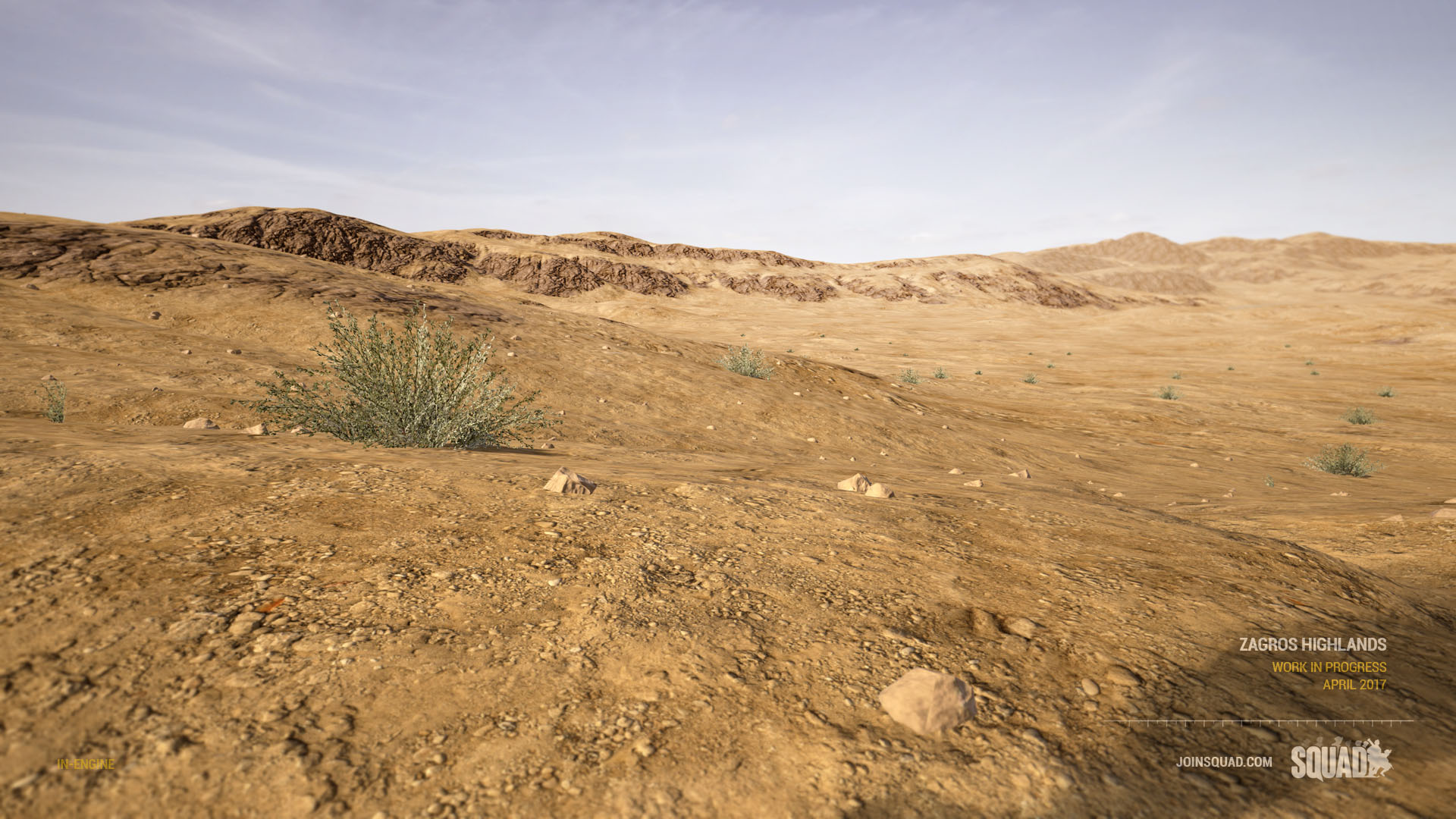

Combining ideas from a few of our partners, this game mode will consist of 7 conquest flags occupying hilltops. Each team will be allowed 10 minutes to pre-build bases on their two round start control points, after which a global combat barrier will drop and teams will be free to attack each other.
We're looking forward to hearing what you think of the new game modes, so don't be shy if you've got feedback after it all goes down. Whether you're playing or watching, we hope everyone enjoys the experiments we'll be streaming on Twitch this Sunday, April 30th!
Offworld Out.
It's time for another Squad update and special event announcement!
In conjunction with several of our community partners we are excited to announce a special game mode testing event this coming Sunday, April 30th at 2 PM PST.
Our community partners came up with some ideas that we've crafted into two very simple gameplay layers, so on Sunday we're all about stretching the boundaries of everyday Squad play to test an experimental map and game mode!
Desmo's playground - VC_v1 (Vehicle Combat)



Designed by our very own DesmoLocke, this layer consists of enough vehicles to mount an entire team in extended vehicular warfare. With 50 vehicles, 1000 tickets, and 3 very large control zones, we are certain to get into some wild adventures!
Zagros Highlands - Conquest Hardened



Combining ideas from a few of our partners, this game mode will consist of 7 conquest flags occupying hilltops. Each team will be allowed 10 minutes to pre-build bases on their two round start control points, after which a global combat barrier will drop and teams will be free to attack each other.
We're looking forward to hearing what you think of the new game modes, so don't be shy if you've got feedback after it all goes down. Whether you're playing or watching, we hope everyone enjoys the experiments we'll be streaming on Twitch this Sunday, April 30th!
Offworld Out.
Well I just bought a GTX 1070 today for the game so hopefully that will remove the graphics bottleneck. Will get cracking on the 3970X overclock. Hopefully we should be able to crack 40-50fps @ 1440p. If not then it might be a 7700k on the horizon..
Nice, I almost treated myself to a 1080 a few days ago but for some reason decided against it...not sure how much longer I can hold out!
That vehicle map - Imagine the wolf pack!
It should be quite interesting! If you've got a lower spec machine you WILL have problems with it. This is just an early test to see how far we can push it currently. Shame I'm away until Monday evening so I'll miss the carnage!
Hello! If you're here, then you're interested in playing in the Squad experimental event featuring a 6km X 6km map called Zagros Highlands this Sunday, April 30th, 2017 at 14:00 PST! The map will feature two new gamemodes called Vehicle Combat and Conquest Hardened. Read more about it here!
Please provide your in-game name and your Steam ID 64 to sign up! Sign up link.
Simply copy your Steam profile link and paste it here to look it up! https://steamid.io/lookup
If the number of sign-ups is more than the available number of slots, then a lottery will pick members randomly. I'll post the roster Saturday. Good luck!
Disclaimer: Zagros Highlands is a huge map with very little done as far as optimizing it. Lower tier PCs may struggle to perform well. This shouldn't dissuade you from signing up! Just wanted to let you know.
Sign-ups are open! https://www.signupgenius.com/index.cfm?go=s.signup&urlid=5080f44afac2ba2f94-desmos&useFullSite=true
Please provide your in-game name and your Steam ID 64 to sign up!
Simply copy your Steam profile link and paste it here to look it up! https://steamid.io/lookup
The number of sign-ups is more than the available number of slots, so a lottery will pick members randomly. I'll post the roster Saturday. Good luck!
Disclaimer: Zagros Highlands is a huge map with very little done as far as optimizing it. Lower tier PCs may struggle to perform well. This shouldn't dissuade you from signing up! Just wanted to let you know.
Please provide your in-game name and your Steam ID 64 to sign up!
Simply copy your Steam profile link and paste it here to look it up! https://steamid.io/lookup
The number of sign-ups is more than the available number of slots, so a lottery will pick members randomly. I'll post the roster Saturday. Good luck!
Disclaimer: Zagros Highlands is a huge map with very little done as far as optimizing it. Lower tier PCs may struggle to perform well. This shouldn't dissuade you from signing up! Just wanted to let you know.
Not mine! Shame I won't be able to play at that time. Looking forward to the VOD though. Can you tell us anything about how the animation changes and Core Inventory updates are going Xcept? Has there been any buzz with the International Comp at OWI. Any favorites? My team FFO are playing in two weeks time against the french team - should be a good fight.
Is that Asteryks? They are pretty good although my money is on you FFO guys
 Just seen the new website for the tournament too, very nice! http://internationalsquad.com/
Just seen the new website for the tournament too, very nice! http://internationalsquad.com/Anim and inventory systems are chugging along nicely. It's going to feel so much better than how it is now. v9.5 first which is getting closer and closer.

Alpha 9.4
Hi Squaddies,
In a surprise turn of events, we have yet another content release in the form of Alpha version 9.4!
While we have been hard at work getting our big systems integrated for the upcoming v10 release, we just couldn't let you sit around for months and not get some cool stuff in the meantime. So some of us decided you guys need some juicy new toys for all factions including mortars, mines, IEDs and a few new vehicles to boot. Additionally, we have made some gameplay changes and balance tweaks to further improve upon what we did with v9.
Version 9.4 is now available via Steam. Please always reset your appdata in the game settings on every new build!

Full Changelog
Gameplay
- All vehicles in the game has had a ticket reduction, some more than others. Check out this reference sheet for details.


- All Recruit kits now have an entrenchment tool so they have a better chance of getting a kit back after a squad kick/leave.
- When a Heavy Anti Tank (HAT) directly hits an Armored Personnel Carrier (APC; Stryker, MTLB, BTR variants) it will no longer instantly blow up. The vehicle will burn up and be destroyed, but now the crew and passengers has a chance to get out and fight through the ambush.
- Heavy Anti Tank kit moved to the Fire Support category so that the squad must think a little harder on which kits they want in the squad and what they will have to be without.
- Heavy Anti Tank kit is now limited to max of 1 per team, it still unlocks at 20 players on your team.
- All medics now have one fragmentation grenade.
- Reduced fragmentation grenades from 2 to 1 for the Scout kit.
- Limited the Scout kit to a maximum of 6 per team.
- Increased the limit on the Scout kit from 3 to 4 squad members before it is available.
- Added 1 TM-62 anti tank mine, one large IED, an IED phone detonator and 5 decoy rocks to the Scout kit.


- Added Deployable rocks and covers to the scout class for mine concealment
- A Scout can have up to 3 anti tank mines deployed at any time, up to 5 decoys deployed at any time and only 1 large IED on the map at a time. Placing a new one will remove the oldest from the world. When you have placed a mine or IED you can dig it further into the ground to help conceal it, or leave it in plain sight to attempt to spook and funnel enemies into your other explosives or ambushes. This also means that your enemies can dig them up and thus neutralize them.
- Added M1937 82mm Mortar for Insurgents and Militia, 2B14 Podnos 82mm Mortar for Russia and M252 81mm Mortar for the US army. Costs 300 construction points and are limited to 2 per FOB. Mortars come with a 'magazine' of 3 rounds at the ready, reloading this magazine costs 90 ammo points from the FOB.
- The current set of mortars in Squad has about 1230m effective range on a level surface, you will have to migrate your fire support battery to a closer FOB if you cannot reach your target. All mortars fires standard High Explosive rounds - more options will be available in the future. Tip: using the arrow keys on your keyboard will add/subtract 1 mil from your current angle.



- Added M-ATV MRAP Heavy Jeep for US, comes both with and without CROWS.



- Added MT-LBM 6MA variant (armed with a KPVT 14.5mm turret) for Russia.
- All main bases now have a no deployable zone.
- Decreased volume of engine sounds when inside a vehicle
- Changed the way RPG-7 and SPG-9 rockets behave. Previously they all had too high muzzle velocity, now they have an accurate and lower muzzle velocity and a rocket assisted boost after leaving the barrel. There is greater differentiation between the different round types. Fragmentation rockets fly the straightest, HEATs drop a bit more and the heavy Tandem Round finally feels as fat as it looks.
- Reduced the rearming time on 30mm cannons to be more in line with the other vehicles
- Added randomized deflection for penetrating projectiles. Upon exiting a material a bullet will deflect depending on the material and the caliber of the weapon. A good rule of thumb is that the bigger the caliber the straighter it will continue to fly through objects because of its momentum.


Systems
- Created a no deployables zone that stops deployables from being used near main bases and caches.
- Added better benchmarking that now runs on your first run of the game, or when manually triggered, instead of defaulting all players to epic settings.
- Sorted all deployables into subcategories to allow for more options.
- Added rocket acceleration to rocket projectiles.
- Added Invasion gamemode and ruleset.
- Made team score not scroll on the scoreboard
- Added turret sounds to the BTR

- Updated the map grid system to be dynamic and more consistent for all map layers, there is now Major (300m), Minor (100m), Sub (33m) grids.
- Added dynamic map scale legend.
- Added grid reading to the map, the map will now show your current location player location or the location of your mouse on the map if in the spawn screen.
- Added a green 'Request Fire mission' marker for Squad Leaders to use when communicating with mortar squad. Easier to differentiate than calling out which MG marker you want to fire at.
- Added Enemy Mortar Spotted marker for marking enemy artillery positions.
- Added a Vehicle Health Bar for when you're inside a vehicle.
- Ambient Audio overhaul on maps Kokan and Al Basrah
- Modified 3p pistol fire sounds and added new Makarov fire sounds
- Modified M2 HMG close up fire sounds
- New .50cal bullet snaps
- Added Mortar sounds; fire and explosion sounds. New incoming projectile sound system with sound triggers at certain heights.
- Added Mine explosion sounds
- Gorodok AASv1 and AASv2 layers have been adjusted to increase frequency of combat.
- New Lighting has been done for all Al Basrah layers.
- Relight on Yehorivka AASv2 as it was too dark
- Replaced trees on fools road with more 'old growth' feel. Quite different!
- Jensen's Range has been dramatically upgraded functionally, as well as to include signage intended to help new players
- New game mode has been added called 'Invasion'. This game mode bears resemblance to Kohat AASv2 Radio Tower. One 'underpowered' side starts with all but the first flag and the attacking team needs to capture all flags in order to reach the last objective to win.
- Maps containing Invasion game mode: Al Basrah, Chora AASv2 Night has been converted to Invasion, Kohat AASv2 Radio Tower renamed to Invasion, Gorodok, and Yeho.


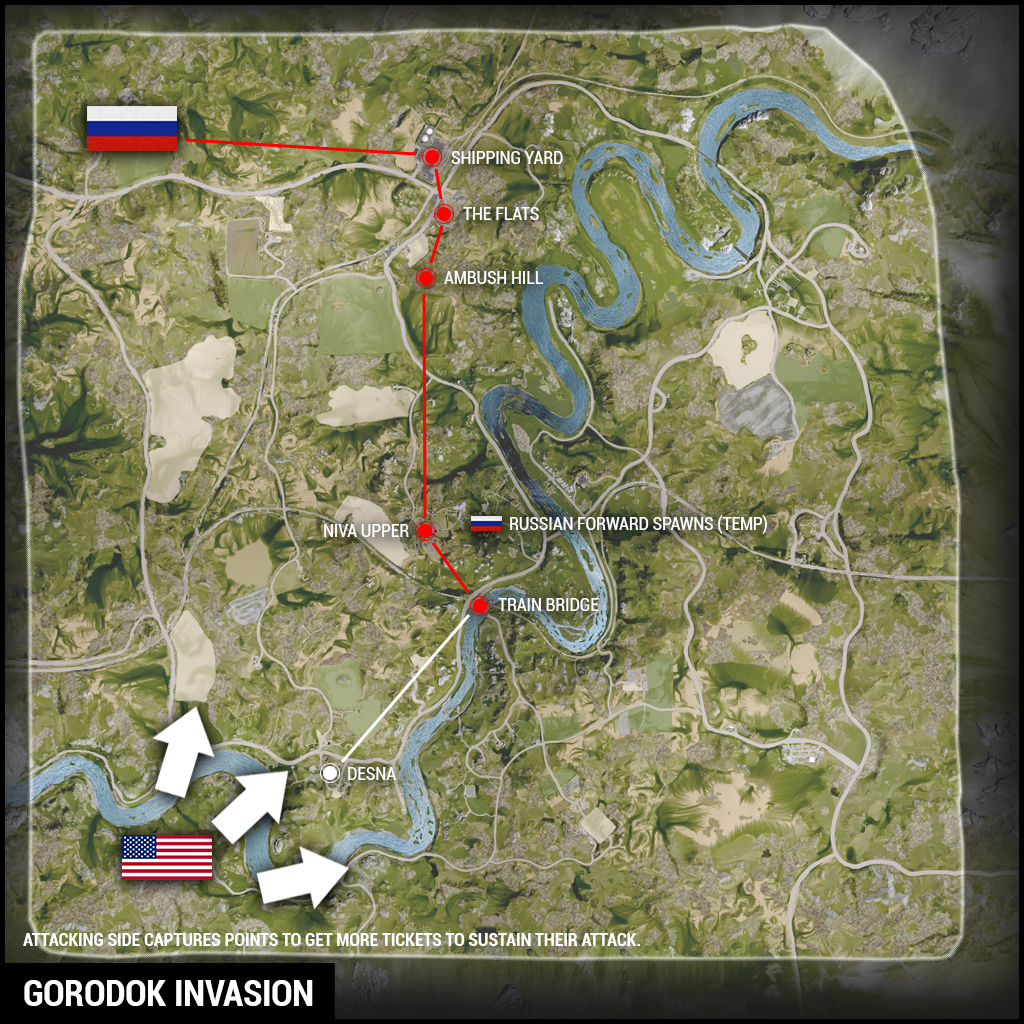
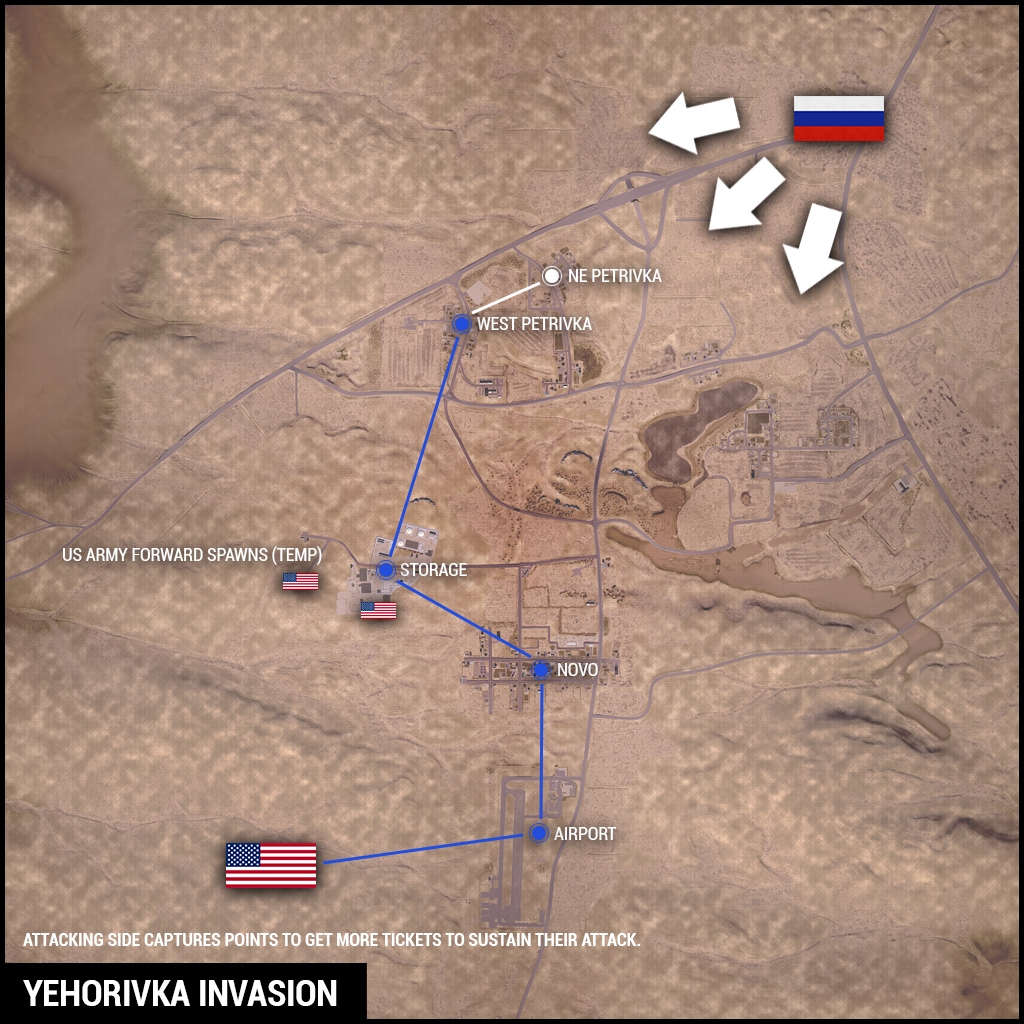
- INS and MIL have had their base global tickets increased by 50-75 tickets on primary AAS layers to account for their unconventional nature.
- Expanded storage site on Yeho AASv1 to incorporate the entire area.
- Conquest layers have had their tickets increased for both teams from 500 to 800.
- Logistical trucks have been added to all INF layers for future proofing and general gameplay.
- Fixed game mode rules often not being shown or being showed incorrectly
- Fixed map legend not working
- Fixed radial menu tooltips not working
- Fixed the stamina widget showing when dead or in vehicles
- Fixed shovels not finding the collision of deployables properly, it is now much easier to use the shovel.
- Fixed insurgency cache spawning
- Fixed many causes of soldiers getting offset in vehicles after getting ragdolled
- Fixed movement code multipliers sometimes not applying correctly
- Fixed movement code bugging out when trying to sprint backwards (we now allow slow movement backwards in this case instead of the old bug)
- Fixed alignment issues in the grid system when zoomed in, you now get the correct grid at all times.
- Fixed various physmat assignments
- Fixed Flag loss component not awarding tickets when capturing a flag
Offworld Out.
Join the Discussion >>
Cheers guys. Originally we wanted it out of the door straight after the event at the weekend but we couldn't squish all the bugs in time.
I've seen a lot of SBVIEDs and mortar fun so far, just don't waste too many tickets attaching those IEDs to vehicles!
I've seen a lot of SBVIEDs and mortar fun so far, just don't waste too many tickets attaching those IEDs to vehicles!

DevBlog
Out & About
Trip to the The Tank Museum at Bovington

Hi Squaddies,
Do you like tanks? We like tanks.
While we gear up the development of more war machines, we thought we would share an insight into a new workflow we are refining. In a bid for continual improvement, we have employed photogrammetry, which is the process of recreating objects in 3D from a set of photographs.
By taking photographs from as many different angles as possible, software can find common points in each. Through triangulation, specialist photogrammetry software can then calculate the position of these points. Do this many, many times, and you end up with with a 'Sparse Point Cloud' vaguely defining the shape of the object photographed. Interpolating these results yields a 'Dense Point Cloud', and from this, a high-resolution 3D mesh and texture can be produced.

Development of tanks for video games is a time-consuming process. Especially if, like us, you care about accuracy. Insuring proportions, shapes and details are correct can be difficult and drawn out. This is usually done by 'eyeballing' reference imagery and matching parts to known dimensions. A lucky artist will have access to some blueprint material, but these can often be incorrect or unhelpful.
To alleviate this issue, we concocted a plan. A plan to ensure accuracy and reduce development time. We headed out to The Tank Museum in Bovington, UK. What awaited us here was a large array of distractions in the form of a plethora of armour. Nonetheless, we set our sights on our targets - an East German T-72M1, a Challenger 2 V5 Prototype, and a Russian T-62.
Our intention was to scan these tanks, with a view to replace our entire 'block out' phase of development. Blocking out is the process of establishing general proportionality in a rough model before embarking on the process of subdivision modeling. Moreover, although these are not the exact models we need, only small modifications will need to be made. A 3D scan would provide us with all of these proportions to a significant degree of accuracy, in a fraction of the time.

We set up our tripods and got to work, marching up and down ladders to capture the full glory of these beasts. We shot them a good 1600 times, capturing approximately 500 images of each. DSLR cameras with wide angle lenses were essential here - allowing us to get in close and capture a lot of tank per shot. A low ISO of around 100 and an aperture above f10 also increased the image quality and thus the software's ability to track key points.
After a lengthy day of photography, it was time to retire back to our Airbnb, crack open a few beers and spend the night processing images and feeding them to RealityCapture. Our laptops churned away, and after a few hours, we got our results:


T-72M1 Scan Result

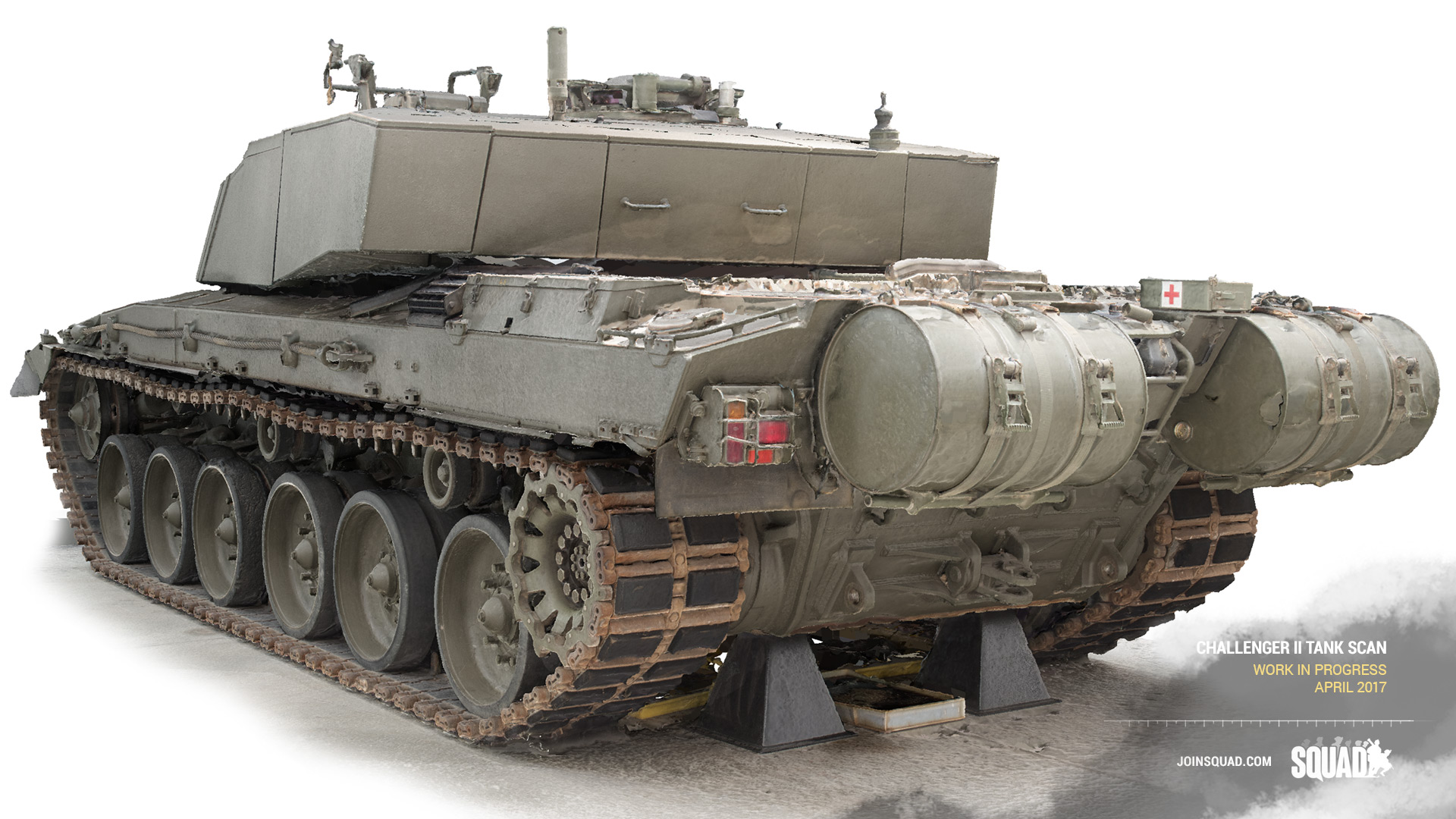
Challenger II Prototype Scan Result


T-62 Scan Result
Considering we aimed to capture the basic shapes, we were taken aback with the quality and the complexity of the results. The level of detail captured will further aid accuracy and detail replication.
However, we did not stop there, taking the opportunity to visit another T-72 in the workshop. We tentatively dangled our rented equipment into the maw of the tank, withdrawing a set of interior photospheres. These will provide excellent reference material and are interesting to view:
There are some considerations to be made when undertaking photogrammetry. Lighting must be consistent throughout the shoot, to aid in the software matching points. This is especially important if using the texture information in-game, so the colour and exposure remain uniform. Ideally, we would want the lighting to be entirely neutral - so not to conflict with the physically correct lighting.
While we were not aiming to use these models in-game but purely as a reference, we did take the opportunity to do some experimentation with neutralizing the effect of lighting in the museum. The technique, we reasoned, could be especially useful when applied to environment assets. This could be achieved by taking a high dynamic range photosphere of the museum, using a camera mounted on top of the relevant tank.
To accomplish this, we used a Nodal Ninja panoramic head and a 10.5mm rectangular fisheye lens. Then seven brackets were shot with 1 EV increments, in 8 different positions. This technique was then processed and stitched, ultimately producing a high dynamic range, 360 view photograph.
Using this as an environment map in 3DS Max and utilizing a photograph of a 'Chrome Ball' to correctly align it with the model, a lighting map can be baked out using the mental ray renderer. Dividing this in Photoshop, should, in theory, produce a texture map with the lighting removed.
This did not work for us in practice this time, but the setup did allow us to capture the T-72 interior. We identified a couple of areas of an issue with this process. Firstly, you cannot recover colour data where the exposure is too low. Secondly, artificial lights do not translate well in this manner. Shadows produced by mental ray were soft where they should have been sharp; this is likely due to reduced dynamic range and lack of directionality.
Properly balancing light levels, especially around the tracks and areas illuminated by spotlights, was impossible. Incorrect exposure destroys details in scans, but we found a stop-gap fix of using mixed exposure settings. Our proposed solution for future scans is to take three brackets of exposure and collapse these into 32-bit TIFF files. This will give the software a greater range of detail to work with, and tone mapping the resultant texture will yield properly exposed textures. The issue of spotlight shadows could theoretically be solved by probing the spotlight luminance individually and placing lights in 3DS Max, but this is beyond reasonable for our process.
Overall, our trip was a big success concerning results and experience. We are looking to return to Bovington to employ this technique again in the future. We thoroughly enjoyed our time at The Tank Museum and would like to thank them for having us. They run an excellent charity dedicated to preserving the history of these magnificent machines, along with the people who crewed them. A few of us will be visiting again in June for Tank Fest, and we hope to see some of you down there!

Vancouver Range Day
In an attempt to do more 'hands-on' research for our Animation and Game Design team, the team decided to take the opportunity to go to a local Vancouver gun range! Our very own Military Adviser and Game Designer SgtRoss was also in town, flying all the way up to Vancouver from Texas, so the experience at the range was just as enlightening as it was fun.
The Range Langley was the place that hosted us for the day, an indoor 25m long range that accommodated all kinds of firearms and shooting needs.
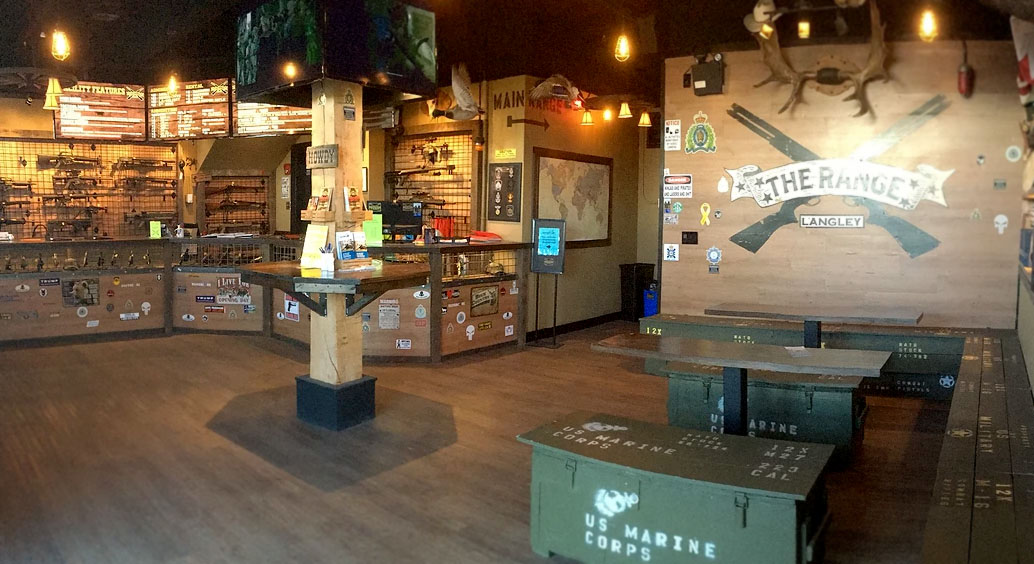
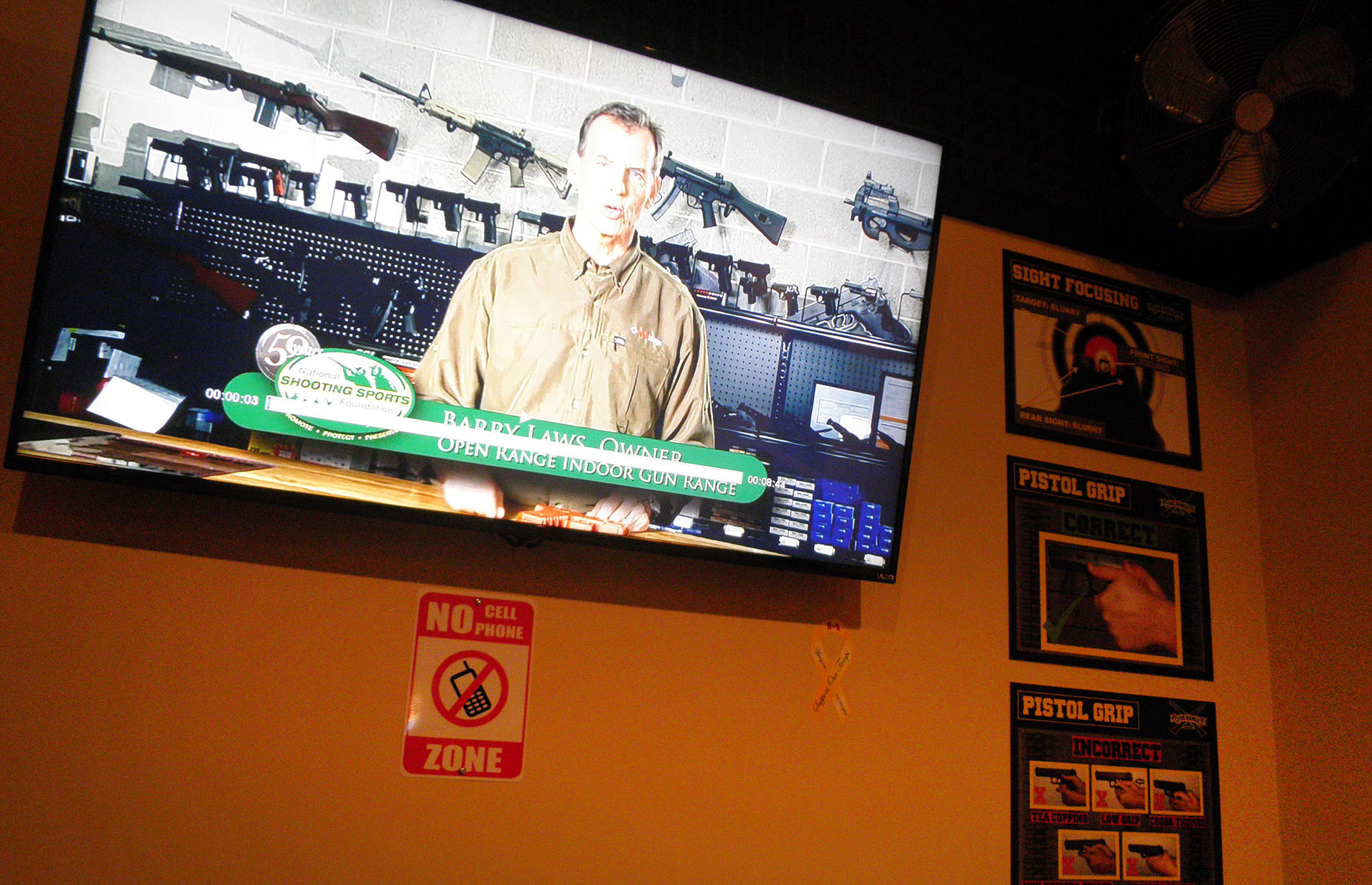
We also were treated by a couple of friends of OWI, Original Project Reality Founder 'Eggman', and his friend Jan. They were kind enough to provide a lot of the firearms we would shoot during the day, as well as the ammunition.


Project Reality Founder 'Eggman' grinning with a SKS with the bayonet out
The team that was present (Chuc, Merlin, Norby and SgtRoss) got a lot of valuable first-hand experience of shooting firearms, but also discussing in-game applications and also seeing how a trained veteran expertly handle firearms. Reference material shot on the day as well as a study of the target groupings shot at various CQB ranges will provide the team with a valuable touchstone for firearms handling in Squad for the upcoming new animation system.
Offworld Out.
Join the Discussion >>
I notice in the graphics settings tab, Effects, i usually chouce EPIC, as that means highest, but there is now a Cinematic setting on the end, what does that actually do, and will it drop fps even lower ? cheers
Cinematic effects is just a better tickrate on things like explosions, bullet impacts etc. It will look much more "fluid".
The old ones were capped to 60fps but now they will play at whatever your system can output.
It's not really noticeable during normal play but if you're capturing videos with the adminSlowmo command then it looks much better. I've not noticed any performance drop running it on my 4790k and 970.



